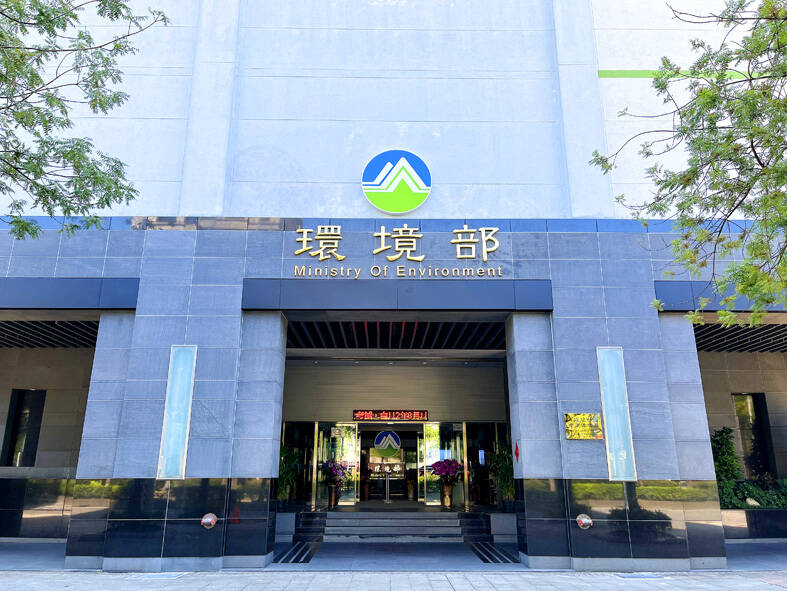The Ministry of Environment has released updated National Climate Change Action Guidelines, incorporating the goal of net zero emissions by 2050 and more details on key strategies first announced in March last year.
Following a revision of the Greenhouse Gas Reduction and Management Act (溫室氣體減量及管理法) into the Climate Change Response Act (氣候變遷因應法) earlier this year and the announcement of the net zero goal early last year, the ministry updated the guidelines and made the changes public on Thursday.
The revised guidelines retain the aim of the original, namely the need to construct a green and low carbon homeland that is able to adapt to climate risks and ensure the nation’s sustainable development.

Photo: Chen Chia-yi, Taipei Times
Also retained were the objectives to enhance the country’s adaptability and resilience against climate change, as well as reducing greenhouse gas emissions.
One key difference is that in 2017 the objective was the gradual reduction of greenhouse gas emissions to 50 percent of 2005 emissions level by 2050, while the latest version seeks to achieve net zero emissions by that year.
The guidelines also lay down general principles to be observed by the government.
The unchanged principles include complying with the Kigali Amendment to the Montreal Protocol, which calls for the gradual phasing-out of hydrofluorocarbons, and the Paris Agreement.
Others are transparency in policymaking, enhancing science-based climate change-adaptive capabilities, improving the efficiency of energy use, and emphasizing the partnership between the central and local governments, and their cooperation with non-governmental organizations and international actors.
The revised principles in the updated guidelines are those that follow the net zero 2050 transition plan from early last year.
The policy is based on energy, industrial, lifestyle and social transition, while two foundations are to be established to focus on upgrading technological research and development, and bolstering climate-related legislation.
The general principles in the revised guidelines also introduce the concept of justice in transition, highlighting the importance of generational and environmental justice.
The prioritization of the collection of carbon fees through a cap-and-trade scheme is another change, with implementation of a scheme having been “evaluated.”
The “nuclear-free homeland” goal remains in place, underlining that no expansion of nuclear power would be adopted as a means to combat climate change, but in the same sentence it also stresses the reliance on fossil fuel would be gradually lowered and renewable energy development goals introduced.
Policies for actual climate change mitigation have been outlined in greater detail and include identifying solar power and offshore wind power as mature renewable energy to be further developed and calling for the development of “forward-looking” geothermal, biomass and marine energy.
The construction of a supply and demand system for hydrogen was also highlighted in the updated mitigation policies.

Eight restaurants in Taiwan yesterday secured a one-star rating from the Michelin Guide Taiwan for the first time, while three one-star restaurants from last year’s edition were promoted to two stars. Forty-three restaurants were awarded one star this year, including 34 in Taipei, five in Taichung and four in Kaohsiung. Hosu (好嶼), Chuan Ya (川雅), Sushi Kajin (鮨嘉仁), aMaze (心宴), La Vie by Thomas Buhner, Yuan Yi (元一) and Frassi in Taipei and Front House (方蒔) in Kaohsiung received a one-star rating for the first time. Hosu is known for innovative Taiwanese dishes, while Chuan Ya serves Sichuan cuisine and aMaze specializes

Taitung County is to launch charter flights to Malaysia at the end of this year, after setting up flights to Vietnam and Thailand, the Taitung County Government said yesterday. The new charter flight services, provided by low-cost carrier Batik Air Malaysia, would be part of five-day tour packages for visits to Taitung County or Malaysia. The Batik Air charter flight, with about 200 seats, would take Malaysian tourists to Taitung on Dec. 30 and then at 12:35pm return to Kuala Lumpur with Taiwanese tourists. Another charter flight would bring the Taiwanese home on Jan. 3 next year, arriving at 5:30pm, before taking the

Taiwan High Speed Rail Corp. (THSRC) plans to ease strained capacity during peak hours by introducing new fare rules restricting passengers traveling without reserved seats in 2026, company Chairman Shih Che (史哲) said Wednesday. THSRC needs to tackle its capacity issue because there have been several occasions where passengers holding tickets with reserved seats did not make it onto their train in stations packed with individuals traveling without a reserved seat, Shih told reporters in a joint interview in Taipei. Non-reserved seats allow travelers maximum flexibility, but it has led to issues relating to quality of service and safety concerns, especially during

An exhibition celebrating Taiwan and Japan’s comic culture opened on Saturday in Taichung, featuring a section that explores Taiwanese reproductions of Japanese comics from when martial law limited Japanese representation. “A Century of Manga Culture: An Encounter of Taiwan and Japan’s Youth” held its Taiwan opening ceremony at Taichung’s National Taiwan Museum of Comics after an initial one-month run in Japan’s Kyoto International Manga Museum between May 24 and June 24. Much like the Kyoto exhibition, the show mainly celebrates the comic connection between Taiwan and Japan through late Taiwanese comic book